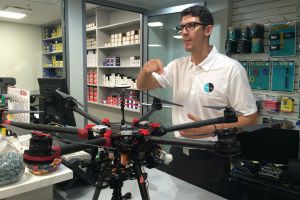 Cayman Island law-enforcement officials have a new use for public-safety drones – prison patrol.
Cayman Island law-enforcement officials have a new use for public-safety drones – prison patrol.
The Cayman Islands Prison Service recently launched a drone training program to patrol prison facilities in search of would-be smugglers.
Local UAV firm AirVu landed a contract last year to provide imagery quadcopters along with intensive training to prison guards in an attempt to quell a common problem in the prison system– drug smuggling.
“[Drones] don’t get tired and don’t need a drink and don’t need a break,” Cayman prison service director Neil Lavis stated in a press release, adding that the new program will provide a “significant addition to fight crime”
Not more than a week after initial training, the drone patrol got a real-world test on April 13 when prison officials and police recovered a large cache of marijuana that had been thrown over a prison fence in an effort to reach inmate dealers.
Police didn’t catch the smugglers, who were described as two men carrying backpack. The suspects escaped into the forest but police easily located the drugs using quadcopters.
“The vacant land leaves the prisons perimeter vulnerable to those intent on trafficking contraband. However, with the aid of the drone, more area can be covered and once detected, will be able to assist in locating suspects and drugs,” a government press release stated.
“We are always trying to be on the cutting edge in the fight against drugs and contraband getting into the prisons,” Lavis added.
The Royal Cayman Islands Police Service plans to ramp up drone deployment across the island nation for police investigations, search-and-rescue, as well as traffic control.
The law-enforcement service typically uses helicopters for similar missions at a cost of up to $2,000 permission. The new Cayman drone patrol will be able to fly similar missions for hundreds of dollars.
AirVu markets both fixed-wing and rotary drones to public-safety agencies in the Caribbean region. The firm also provides ground stations and states that their drones can fly “autonomous missions [and] provide continuous HD video footage day or night over land or sea.”
Jason is a longstanding contributor to DroneLife with an avid interest in all things tech. He focuses on anti-drone technologies and the public safety sector; police, fire, and search and rescue.
Beginning his career as a journalist in 1996, Jason has since written and edited thousands of engaging news articles, blog posts, press releases and online content.
Email Jason
TWITTER:@JasonPReagan
Subscribe to DroneLife here.







[…] The exploding counter-drone industry could prime almost $2 billion by 2024. As drone use grows, quite a few general public agencies and organizations are seeking anti-drone answers to prevent drones from traveling about restricted or unsafe spots such as wildfire zones, nuclear electrical power vegetation, prisons and airports. […]